IC 418 facts for kids

IC 418 is a beautiful object in space known as a planetary nebula. It is found in the constellation called Lepus, which looks like a rabbit. This amazing cloud of gas and dust is about 1,100 light-years away from Earth. That's a very long distance!
Contents
What is a Planetary Nebula?
A planetary nebula is not actually a planet. It's a huge, glowing cloud of gas and dust. These clouds form when a star like our Sun reaches the end of its life. The star throws off its outer layers of gas into space. This gas then glows brightly because of the hot star still at its center.
Why is it called a "Planetary" Nebula?
Early astronomers, who looked at these objects through their telescopes, thought they looked like planets. This is because they often appeared round and colorful. Even though we now know they are not planets, the name "planetary nebula" stuck.
The Spirograph Nebula
IC 418 is often called the "Spirograph Nebula." This name comes from its unique and beautiful shape. When you look at its pictures, especially those taken by the Hubble Space Telescope, it looks like a drawing made with a Spirograph toy. It has intricate patterns and swirls.
What Makes it Glow?
The gas in IC 418 glows because of the very hot star at its center. This star is a type of white dwarf star. It is the leftover core of the original star. The intense ultraviolet light from this hot star makes the surrounding gas light up. Different gases glow in different colors, creating the nebula's vibrant look.
How Big and Far Away is IC 418?
IC 418 is quite large, even though it looks small from Earth. It is expanding outwards as the gas moves away from the central star. A light-year is the distance light travels in one year. Since IC 418 is 1,100 light-years away, the light we see from it today actually left the nebula 1,100 years ago!
The Star at its Heart
At the very center of IC 418 is a small, very hot star. This star was once much larger, similar to our Sun. As it aged, it used up most of its fuel. It then expanded into a red giant star. After that, it shed its outer layers, forming the nebula we see today. What's left is a tiny, dense white dwarf star. This white dwarf is slowly cooling down over billions of years.
The Future of IC 418
Planetary nebulae like IC 418 do not last forever. The gas and dust will continue to expand and spread out into space. Eventually, the nebula will become too thin to be seen. This process takes tens of thousands of years. The central white dwarf star will continue to cool down until it becomes a black dwarf, which is a cold, dark remnant of a star.
Discovery of IC 418
IC 418 was first discovered by an astronomer named Edward Charles Pickering. He found it in the late 1800s. It was later added to the Index Catalogue (IC), which is a list of nebulae, star clusters, and galaxies. This is how it got its name, IC 418.
See also
 In Spanish: IC 418 para niños
In Spanish: IC 418 para niños

